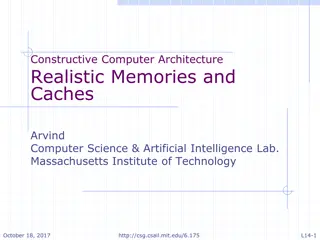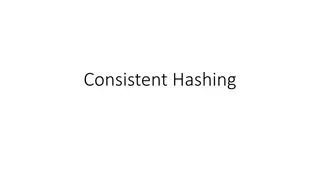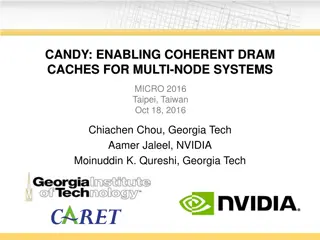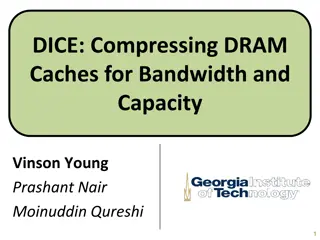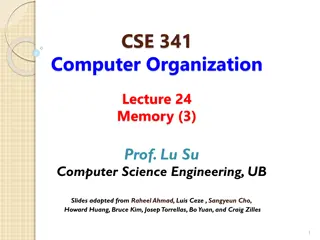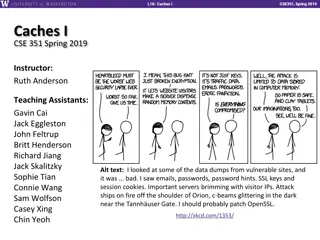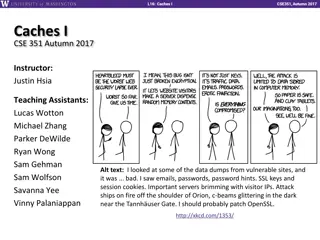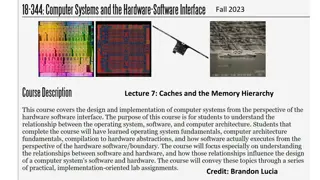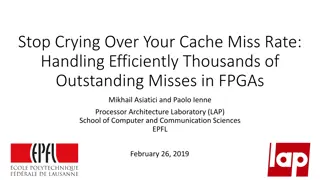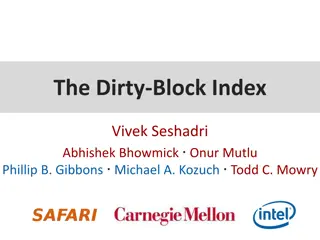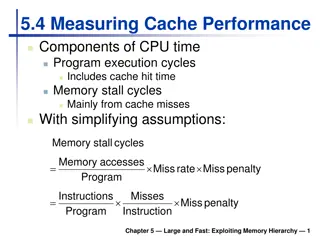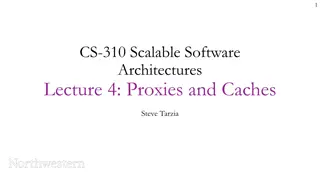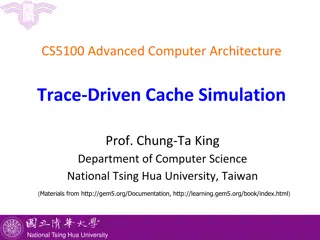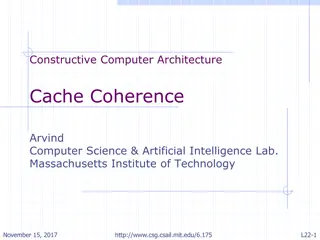
Efficient Memory Management Techniques in Computer Architecture
Explore the intricacies of memory organization, caches, and memory hierarchy in computer systems. Learn about realistic memories, multistage pipelines, magic memory models, cache organization, and memory read behavior.
Download Presentation

Please find below an Image/Link to download the presentation.
The content on the website is provided AS IS for your information and personal use only. It may not be sold, licensed, or shared on other websites without obtaining consent from the author. If you encounter any issues during the download, it is possible that the publisher has removed the file from their server.
You are allowed to download the files provided on this website for personal or commercial use, subject to the condition that they are used lawfully. All files are the property of their respective owners.
The content on the website is provided AS IS for your information and personal use only. It may not be sold, licensed, or shared on other websites without obtaining consent from the author.
E N D
Presentation Transcript
Realistic Memories and Caches Arvind Computer Science & Artificial Intelligence Lab. Massachusetts Institute of Technology March 9, 2016 http://csg.csail.mit.edu/6.375 L12-1
Multistage Pipeline fEpoch Register File redirect eEpoch nap e2c PC Execute Decode d2e Data Memory Inst scoreboard Memory The use of magic memories (combinational reads) makes such design unrealistic http://csg.csail.mit.edu/6.375 March 9, 2016 L12-2
Magic Memory Model WriteEnable Clock Address MAGIC RAM ReadData WriteData Reads and writes are always completed in one cycle a Read can be done any time (i.e. combinational) If enabled, a Write is performed at the rising clock edge (the write address and data must be stable at the clock edge) In a real DRAM the data will be available several cycles after the address is supplied March 9, 2016 http://csg.csail.mit.edu/6.375 L12-3
Memory Hierarchy Small, CPU RegFile Big, Slow Memory DRAM Fast Memory SRAM holds frequently used data size: latency: bandwidth: on-chip >> off-chip RegFile << SRAM << DRAM RegFile << SRAM << DRAM why? On a data access: hit (data fast memory) low latency access miss (data fast memory) long latency access (DRAM) March 9, 2016 http://csg.csail.mit.edu/6.375 L12-4
Cache organization address line-addr Main Memory Processor Cache word line-data Temporal locality: A recently accessed address has a much higher probability of being accessed in the near futurethan other addresses Spatial locality: If address a is accessed then locations in the neighborhood of a, e.g., a-1, a , a+1, a+2, are also accessed with high probability Therefore processor caches are almost always organized in terms of cache lines which are typically 4 to 8 words It is also more efficient to transfer cache lines as opposed to words to the main memory cache line = <Add tag, Data blk> If the line size is 4 words then the address tag is 4 bits shorter than the byte address and the data block size is 4 words March 9, 2016 http://csg.csail.mit.edu/6.375 L12-5
Memory Read behavior Search cache tags to find match for the processor generated address Found in cache a.k.a. hit Not in cache a.k.a. miss Return copy of requested word from cache Is there an empty slot in cache? no yes Select a cache line to evict and write it back to memory if it is dirty (need a replacement policy) Read block of data from main memory, update cache and return the requested word March 9, 2016 http://csg.csail.mit.edu/6.375 L12-6
Memory Write behavior Search cache tags to find match for the processor generated address Found in cache a.k.a. hit Not in cache a.k.a. miss Update appropriate word in cache line Is there an empty slot in cache? no yes Select a cache line to evict and write it back to memory (Need a replacement policy) Read block of data from main memory, update Update appropriate word in cache line write-back, write-miss-allocate cache March 9, 2016 http://csg.csail.mit.edu/6.375 L12-7
Store Buffer: Speeding up Store Misses A unlike a Load, a Store does not require memory system to return any data to the processor; it only requires the cache to be updated for future Load accesses A store can be performed in the background; In case of a store miss, the miss can be processed even after the store instruction has retired from the processor pipeline March 9, 2016 http://csg.csail.mit.edu/6.375 L12-8
Store Buffer mReqQ L1 mRespQ Store buffer Store Buffer (stb) is a small FIFO of (a,v) pairs A St req is enqueued into stb if there is no space in stb further input reqs are blocked Later a St in stb is stored into L1 A Ld req simultaneously searches L1 and stb; in case of a miss the request is processed as before Can get a hit in at both places; stb has priority A Ld can get multiple hits in stb it must select the most recent matching entry March 9, 2016 http://csg.csail.mit.edu/6.375 L12-9
Internal Cache Organization Cache designs restrict where in cache a particular address can reside Direct mapped: An address can reside in exactly one location in the cache. The cache location is typically determined by the lowest order address bits n-way Set associative: An address can reside in any of the a set of n locations in the cache. The set is typically determine by the lowest order address bits March 9, 2016 http://csg.csail.mit.edu/6.375 L12-10
Direct-Mapped Cache The simplest implementation Block number Block offset req address Tag Index Offset t k b Data Block V Tag 2k lines t = HIT Data Word or Byte Strided = size of cache What is a bad reference pattern? March 9, 2016 http://csg.csail.mit.edu/6.375 L12-11
2-Way Set-Associative Cache Block Offset Tag Index b Reduces conflict misses by allowing a cache line to go to several different slots in a cache t k V Tag Data Block V Tag Data Block t Data Word or Byte = = hit March 9, 2016 http://csg.csail.mit.edu/6.375 L12-12
Replacement Policy In order to bring in a new cache line, another cache line may have to be thrown out. Which one? No choice in replacement in direct-mapped caches For set-associative caches, select a set from the index Select the least recently used, or most recently used, random ... Select a not dirty set How much is performance affected by the choice? Difficult to know without benchmarks and quantitative measurements March 9, 2016 http://csg.csail.mit.edu/6.375 L12-13
Blocking vs. Non-Blocking cache Blocking cache: At most one outstanding miss Cache must wait for memory to respond Cache does not accept requests in the meantime Non-blocking cache: Multiple outstanding misses Cache can continue to process requests while waiting for memory to respond to misses We will first design a write-back, Write-miss allocate, Direct-mapped, blocking cache March 9, 2016 http://csg.csail.mit.edu/6.375 L12-14
Blocking Cache Interface req missReq memReq mReqQ DRAM or next level cache mshr Processor cache memResp Miss_Status Handling Register mRespQ resp hitQ interface Cache; methodAction req(MemReq r); methodActionValue#(Data) resp; methodActionValue#(MemReq) memReq; method Action memResp(Line r); endinterface We will design a write-back, Write-miss allocate, Direct-mapped, blocking cache, first without and then with store buffer March 9, 2016 http://csg.csail.mit.edu/6.375 L12-15
Interface dynamics The cache either gets a hit and responds immediately, or it gets a miss, in which case it takes several steps to process the miss Reading the response dequeues it Methods are guarded, e.g., the cache may not be ready to accept a request because it is processing a miss A mshr register keeps track of the state of the cache while it is processing a miss typedef enum {Ready, StartMiss, SendFillReq, WaitFillResp} CacheStatus deriving (Bits, Eq); March 9, 2016 http://csg.csail.mit.edu/6.375 L12-16
Extracting cache tags & index tag index L 2 Byte addresses Cache size in bytes Processor requests are for a single word but internal communications are in line sizes (2L words, typically L=2) AddrSz = CacheTagSz + CacheIndexSz + LS + 2 Need getIndex, getTag, getOffset functions function CacheIndex getIndex(Addr addr) = truncate(addr>>4); function Bit#(2) getOffset(Addr addr) = truncate(addr >> 2); function CacheTag getTag(Addr addr) = truncateLSB(addr); truncate = truncateMSB March 9, 2016 http://csg.csail.mit.edu/6.375 L12-17
Blocking cache state elements Vector#(CacheSize, Reg#(Line)) dataArray <- Vector#(CacheSize, Reg#(Maybe#(CacheTag))) tagArray <- replicateM(mkReg(tagged Invalid)); Vector#(CacheSize, Reg#(Bool)) dirtyArray <- replicateM(mkRegU); replicateM(mkReg(False)); Tag and valid bits are kept together as a Maybe type Fifo#(2, Data) Reg#(MemReq) missReq <- mkRegU; Reg#(CacheStatus) hitQ <- mkCFFifo; mshr <- mkReg(Ready); CF Fifos are preferable because they provide better decoupling. An extra cycle here may not affect the performance by much Fifo#(2, MemReq) memReqQ <- mkCFFifo; Fifo#(2, Line) memRespQ <- mkCFFifo; March 9, 2016 http://csg.csail.mit.edu/6.375 L12-18
Req method hit processing It is straightforward to extend the cache interface to include a cacheline flush command method Action req(MemReq r) if(mshr == Ready); let idx = getIdx(r.addr); let tag = getTag(r.addr); let wOffset = getOffset(r.addr); let currTag = tagArray[idx]; let hit = isValid(currTag)? fromMaybe(?,currTag)==tag : False; if(hit) begin let x = dataArray[idx]; if(r.op == Ld) hitQ.enq(x[wOffset]); else begin x[wOffset]=r.data; dataArray[idx] <= x; dirtyArray[idx] <= True; end else begin missReq <= r; mshr <= StartMiss; end endmethod overwrite the appropriate word of the line March 9, 2016 http://csg.csail.mit.edu/6.375 L12-19
Miss processing Ready -> StartMiss -> SendFillReq -> WaitFillResp -> Ready mshr = StartMiss ==> if the slot is occupied by dirty data, initiate a write back of data mshr <= SendFillReq mshr = SendFillReq ==> send the request to the memory mshr <= WaitFillReq mshr = WaitFillReq ==> Fill the slot when the data is returned from the memory and put the load response in the cache response FIFO mshr <= Ready March 9, 2016 http://csg.csail.mit.edu/6.375 L12-20
Start-miss and Send-fill rules Ready -> StartMiss -> SendFillReq -> WaitFillResp -> Ready rule startMiss(mshr == StartMiss); let idx = getIdx(missReq.addr); let tag=tagArray[idx]; let dirty=dirtyArray[idx]; if(isValid(tag) && dirty) begin // write-back let addr = {fromMaybe(?,tag), idx, 4'b0}; let data = dataArray[idx]; memReqQ.enq(MemReq{op: St, addr: addr, data: data}); end mshr <= SendFillReq; endrule Ready -> StartMiss -> SendFillReq -> WaitFillResp -> Ready rule sendFillReq (mshr == SendFillReq); memReqQ.enq(missReq); mshr <= WaitFillResp; endrule March 9, 2016 http://csg.csail.mit.edu/6.375 L12-21
Wait-fill rule Ready -> StartMiss -> SendFillReq -> WaitFillResp -> Ready rule waitFillResp(mshr == WaitFillResp); let idx = getIdx(missReq.addr); let tag = getTag(missReq.addr); let data = memRespQ.first; tagArray[idx] <= Valid(tag); if(missReq.op == Ld) begin dirtyArray[idx] <= False; dataArray[idx] <= data; hitQ.enq(data[wOffset]); end else begin data[wOffset] = missReq.data; dirtyArray[idx] <= True; dataArray[idx] <= data; end memRespQ.deq; mshr <= Ready; endrule March 9, 2016 http://csg.csail.mit.edu/6.375 L12-22
Rest of the methods method ActionValue#(Data) resp; hitQ.deq; return hitQ.first; endmethod method ActionValue#(MemReq) memReq; memReqQ.deq; return memReqQ.first; endmethod Memory side methods method Action memResp(Line r); memRespQ.enq(r); endmethod March 9, 2016 http://csg.csail.mit.edu/6.375 L12-23
Caches: Variable number of cycles in memory access pipeline stages Register File Epoch Next Addr Pred PC Execute Decode m2w f2d d2e e2m f12f2 Data Memory Inst scoreboard Memory insert FIFOs to deal with (1,n) cycle memory response March 9, 2016 http://csg.csail.mit.edu/6.375 L12-24
Store Buff: Req method hit processing method Action req(MemReq r) if(mshr == Ready); ... get idx, tag and wOffset if(r.op == Ld) begin // search stb let x = stb.search(r.addr); if (isValid(x)) hitQ.enq(fromMaybe(?, x)); else begin // search L1 let currTag = tagArray[idx]; let hit = isValid(currTag) ? fromMaybe(?,currTag)==tag : False; if(hit) begin let x = dataArray[idx]; hitQ.enq(x[wOffset]); end else begin missReq <= r; mshr <= StartMiss; end end end else stb.enq(r.addr,r.data)// r.op == St endmethod March 9, 2016 http://csg.csail.mit.edu/6.375 L12-25
Store Buff to mReqQ rule mvStbToL1 (mshr == Ready); stb.deq; match {.addr, .data} = stb.first; ... get idx, tag and wOffset let currTag = tagArray[idx]; let hit = isValid(currTag) ? fromMaybe(?,currTag)==tag : False; if(hit) begin let x = dataArray[idx]; x[wOffset] = data; dataArray[idx] <= x; end else begin missReq <= r; mshr <= StartMiss; end endrule may cause a simultaneous access to L1 cache arrays, because of load requests March 9, 2016 http://csg.csail.mit.edu/6.375 L12-26
Preventing simultaneous accesses to L1 method Action req(MemReq r) if(mshr == Ready); ... get idx, tag and wOffset if(r.op == Ld) begin // search stb let x = stb.search(r.addr); if (isValid(x)) hitQ.enq(fromMaybe(?, x)); else begin // search L1 ... else stb.enq(r.addr,r.data)// r.op == St endmethod lockL1[0] <= True; L1 needs to be locked even if the hit is in stb && !lockL1[1] rule mvStbToL1 (mshr == Ready); stb.deq; match {.addr, .data} = stb.first; ... get idx, tag and wOffset endrule rule clearL1Lock; lockL1[1] <= False; endrule March 9, 2016 http://csg.csail.mit.edu/6.375 L12-27
Memory System All processors use store buffers in conjunction with caches Most systems today use non-blocking caches, which are more complicated than the blocking cache described here The organization we have described is similar to the one used by Intel IBM and ARM use a different caching policy known as write-through, which simultaneously updates L1 and sends a message to update the next level cache March 9, 2016 http://csg.csail.mit.edu/6.375 L12-28



